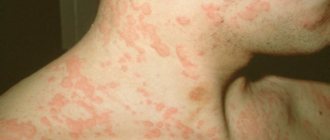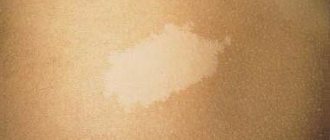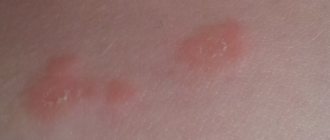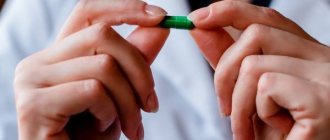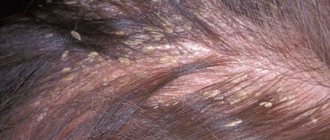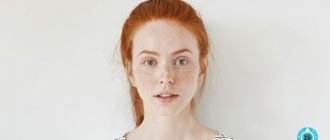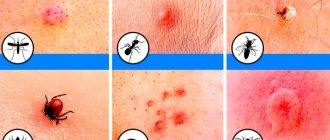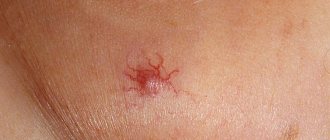Causes of red spots on the temples
There can be a huge number of reasons for the formation of red spots on the temples; in the field of dermatology alone, there are more than 50 diseases that are accompanied by the appearance of red spots. A possible cause for this problem could be psoriasis or seborrhea - the most common diseases with similar symptoms. Especially if the red spots on the temples itch quite a lot.
Psoriasis is a non-infectious disease, but treatment for this cause is quite long and difficult. Often becomes chronic. A signal that the skin is not performing its protective function well is the appearance of seborrhea. Only timely medical therapy guarantees a quick recovery. Other possible causes of this disease may be the following:
- Allergic reaction.
- Rosacea.
- Demodecosis.
- Acne rashes.
- Experiencing stress.
The appearance of acne or pimples is often accompanied by the appearance of red spots, which indicates an inflammatory process. In the case of an allergic reaction, such spots will be localized not only on the temples, but also on other parts of the body. Spots that appear after a severe stressful situation will disappear after some time. Demodicosis is accompanied by severe peeling with the formation of inflammatory foci.
Similar diseases
If a red spot appears on the torso, limbs or neck, then you need to visit a dermatologist, find out the nature of the formation and get recommendations for treatment. Shingles, pityriasis versicolor or rosea, atopic dermatitis, urticaria - these are diseases that cause spots that look like burns.
A formation on a child's face usually indicates lichen. Children of preschool or primary school age become infected after contact with sick animals.
You can see what the spots on the body look like, depending on the disease, in the photos on thematic websites. All information is provided for general information purposes only.
Atopic dermatitis
A chronic skin disease, its exact causes have not yet been studied. Up to 10% of the total population suffers from various forms of atopic dermatitis. It is especially common in children and infants (up to 30% of all cases). Periods of remission alternate with periods of relapse.
Symptoms of the disease:
- red, weeping spots form on the body, they look like lichen, eczema or a burn;
- the rash is accompanied by severe itching, especially worse at night;
- peeling of the skin and hyperemia of the affected areas;
- papules resemble small blisters; in severe forms of the disease they merge with each other.
Shingles
The disease is caused by the herpes virus. Rashes appear on the body, usually on one side, along the movement of the intercostal nerves. A red spot that looks like a burn hurts and itches. New growths are light pink in color, up to five millimeters in diameter. After a couple of days, bubbles with a clear liquid form in their place, after 3-4 days it becomes cloudy. Outbreaks of the disease are diagnosed in the autumn-spring period.
In addition to the rashes, the patient complains of severe pain along the nerves, in the area of the ribs. The pain begins even before the rash appears. Shingles is also characterized by: weakness, chills, headache, elevated body temperature.
Pityriasis versicolor
The disease is also known as tinea versicolor. It is non-contagious and is caused by fungi. Usually occurs in a mild form. There are three forms of the disease: invert, follicular and erythematosquamous.
Regardless of the type of disease, common symptoms stand out:
- the affected areas of the skin peel off;
- the source of infection does not itch or hurt, but if a secondary infection occurs, the patient experiences itching;
- pink spots can be large. Usually located on the back, stomach, head. The spots are asymmetrical with torn edges;
- yellow or brown formations can merge with each other, they are both small and large in size;
- the affected areas of the body do not change color during tanning.
Hives
Dermatosis, in which blisters appear on the skin and mucous membranes. They may be pink, red or brownish in color. In appearance they resemble a burn received from nettles (hence the name).
Most often, hives appear due to an allergic reaction. Appears on different parts of the body. A red spot on the leg that looks like a burn itches. Other reactions include headache, swelling of the affected areas of the body, patients report increased body temperature and general weakness. The reaction lasts from several hours to several days and even months, depending on the influence of the provoking factor.
Pityriasis rosea
This dermatological disease is non-contagious. Pink spots appear on the body. Typically, the pathology occurs in the cold season, and women aged 20-40 are more often susceptible to it.
Initially, a maternal spot forms on the skin (on the back, chest, neck or thigh). It is round or oval in shape, up to 4 centimeters in diameter. After a few days, daughter spots appear all over the body. The maternal plaque grows, can reach up to 10 centimeters in diameter, and has clearly defined edges with a pink or red rim. Every tenth patient is affected by the mucous membranes of the mouth.
Brown spot on temple
The formation of brown spots on various parts of the body is called pigmentation. This process is associated with many reasons that are closely related to the processes that occur in the human body. Brown pigment spots always come in different shapes and sizes. People with sensitive skin to ultraviolet radiation are at risk. The main reasons for the appearance of brown spots on the temples are the following:
1 Age of the person. Age-related pigment spots, often of a dark shade, may appear on the temples and other areas of the skin of the face. There are also some predisposing factors that contribute to the appearance of such skin defects. Among them are the genetic factor, prolonged exposure to the sun, and hypovitaminosis.
2 Stains due to keratosis. A large number of pigment spots may appear due to a disease called keratosis. Peeling, pain when pressed, irritation - all these are signs of actinic keratosis. This pathology requires immediate examination and treatment to prevent it from developing into a cancerous form.
3 Use of drugs. Some medications lead to increased sensitivity to sun exposure and cause irritation.
The signs of this disorder are similar to those of a burn.
Allergy on the legs of a child
Any allergic manifestation on the skin of the legs is the body’s reaction to some irritants. Of course, there are a lot of them, but there are several such factors that experts especially highlight:
- synthetic fabrics;
- animal fur, their saliva;
- uncomfortable shoes.
But there is also an irritant that most often provokes allergic phenomena in a child - food.
Many mothers believe that allergies on the feet can also appear due to the use of certain chemicals - for example, after washing with powders or using conditioner and subsequent poor-quality rinsing. But doctors assure that allergies specifically to washing powders and conditioners in a child primarily appear on the delicate skin of the neck, armpits, and buttocks. We recommend reading: - Contact allergies: causes, symptoms, diagnosis, treatment and prevention - Cosmetics and harmful substances in them: fiction and facts
What should parents do if their children have allergies on their feet?
If peeling, redness, or some kind of “small” rash without signs of an inflammatory process (pimples do not have purulent and/or serous contents) appears on the baby’s legs, then parents should visit a pediatrician. Only a specialist will be able to identify the true cause of allergies on the legs and make some medications if necessary.
Parents can take the following measures as first aid:
If a child has an allergy to his legs immediately after the introduction of a new food product to the menu, then he should immediately abandon this component. During the period of a pronounced condition in question, try to feed the child non-allergenic foods - for example, chocolate, citrus fruits, juices, tomatoes, strawberries are prohibited, even if the child’s body reacted adequately to them in the past. It is very important to reduce the consumption of sugar - it can add skin itching to the existing manifestations of allergies.- Be sure to make sure that the child’s clothes are only made of cotton fabric - synthetic fibers themselves are the cause of the development of allergies on the legs, and if they already have symptoms, this factor will add to the discomfort.
- To bathe a child or wash his feet, you only need warm water with the addition of decoctions of medicinal plants, which have an anti-inflammatory and soothing effect. These include chamomile, string, thyme, sage, calendula flowers, eucalyptus leaves.
- During this period, the child must wear not only comfortable shoes and the exact size - they must be made from natural materials. Be sure to choose shoes “according to the season” - increased sweating makes even minor allergic manifestations on the feet more intense.
Please note: your feet should be warm - even a slight cooling can not only lead to colds, but also become a separate cause of allergies!
- You should only wash your child’s clothes with hypoallergenic washing powders; the best choice in this case would be regular laundry soap. You will have to give up air conditioners and various scented fragrances.
It is not recommended to take any measures to take medications - their choice is the prerogative of a specialist.
How to treat allergies on a child's feet
In general, treatment of allergies is a complex process both in childhood and in adults. No pediatrician will ever prescribe antihistamines even if allergies are intense in a child’s legs. First, all examinations will be carried out to determine the true cause of the body's reaction to external/internal factors - in most cases, an allergy on the child's legs does not require medical intervention at all. Firstly, simply eliminating the irritating factor from a child’s life often helps, and secondly, allergies can “flare up” quickly in childhood, but they disappear just as quickly.
Please note: all of the above does not mean that allergies in a child’s legs can be ignored or treated independently at home!
Parents may confuse allergic manifestations with symptoms of complex skin diseases; the allergen irritant may be completely unexpected, so the body’s inadequate reaction will progress. We recommend reading: - Allergies: causes, types, symptoms, first aid and treatment - Treatment of allergies. Review of third generation antihistamines - Treatment of allergies with folk remedies
Birthmark on temple
Many experts do not recommend rushing to get rid of a birthmark using surgical methods. Moles on the temples can be completely harmless, but sometimes even have a high risk of melanoma formation. If a person is bothered by a birthmark for some reason, then it is worth going to the hospital for consultation.
Congenital pigment spots on the temples can have completely different shapes, colors and sizes. The greatest danger is that there is a risk of melanoma formation. The safest is considered to be a flat nevus, which is light brown or almost black.
A serious reason for going to the hospital may be a change in the color of the birthmark, the appearance of red spots around the birthmark, as well as pigment inclusions. Discomfort, pain, severe itching, a feeling of tightness of the skin - all these signs should make a person worry and seek advice. The most dangerous and serious sign is discharge from a nevus. Only timely treatment can guarantee a speedy recovery.
What is prohibited to do
When treating red spots in a child, you can follow some rules; they will help you cope with any ailments quickly and effectively. Doctors highlight a special list of rules that cannot be broken:
- squeeze out, comb formations on the body. This aspect especially concerns infectious diseases accompanied by severe itching;
- Do not give your baby any medications without first consulting a doctor. It is allowed to use antihistamines for an allergic reaction, only those that you have given to the baby before;
- It is forbidden to smear red spots with any ointments without consulting a pediatrician, especially with dyes.
Pigment spot on temple
Pigment spots are easy to recognize by their characteristic features: shade, clear boundaries and rounded shape. Light pigment spots indicate mild disorders of internal organs. Dark pigment spots pose the greatest threat to human life and health. A dark skin defect in some cases may indicate the appearance of a tumor.
Pigment spots appear most often in the facial area and can be localized on a person’s temples. Frequent appearance of spots is noted during pregnancy or during warm seasons. Pigment defects come in various shades: light, dark, brown, red or almost black. Spots appear on the face or temples for three most common reasons:
- Sunburn.
- Prolonged exposure to ultraviolet rays.
- Poor quality cosmetics.
The appearance of pigment spots after forty years is often not a sign of serious illness, but is a consequence of the natural aging of the skin. But in any case, the appearance of skin defects should cause concern and become a reason to contact a specialist.
Dark spot on temple
Dark spots on the temples are a consequence of increased melanin deposition. Often such manifestations are a sign of a hormonal disorder, but sometimes they are the cause of other diseases. Dark spots on the temples or face are called melasma or chloasma. For the most part, this problem affects pregnant women and those taking hormonal medications; men with dark skin are also at risk.
Treatment of dark spots on the temples involves first finding out the cause of the skin defect. In addition to eliminating the cause, the process of lightening age spots begins. Before going out into the open in sunny weather, you should apply sunscreen to the affected areas. For an effective and quick recovery, it is necessary to accurately identify the cause that caused the dark spot.
Preventing allergies in a child’s hands and feet
We recommend reading: Allergies in children under one year of age: symptoms and treatment
Any allergic reaction is stress for the body. At this moment, the child’s immune system is weakened and if an infectious or viral disease is added to the condition, its course will be severe and can lead to undesirable consequences. In most cases, you can avoid allergies on your child’s hands and feet with simple preventive measures:
- Children's clothes, as well as the child's bedding, should be washed with special washing powders; it is better to avoid using air conditioners; in extreme cases, use hypoallergenic products.
- It is necessary to introduce complementary foods extremely carefully and in small quantities - it is not for nothing that doctors recommend starting with a few drops of juices or ¼ of a teaspoon. The same rule applies to treating a child to exotic fruits and unusual foods - for example, in childhood it is quite possible to do without sushi, passion fruit, mango and other unusual foods.
- A child's consumption of sugar and all sweets should be controlled by parents - constant eating of sweets, cakes, and consumption of sweet carbonated drinks in unlimited quantities can lead to allergies at best, or to the development of diabetes at worst.
- You should not feed your child crackers, chips and other foods whose taste is enhanced by various chemical additives. The same rule applies to the choice of other products - it is well known, for example, that some sweets stain the tongue and lips in bright colors, which can affect health.
- Do not self-prescribe medications - this should be done by a doctor, even if we are talking about a banal antipyretic.
Of course, these preventive measures may not help - allergies on the child’s hands and feet can develop to pollen, sun and cold. But some caution will help you quickly determine the cause of allergies in your arms and legs, which will guarantee the correct choice of treatment regimen.
Tsygankova Yana Aleksandrovna, medical observer, therapist of the highest qualification category
63, total, today
( 57 votes, average: 4.26 out of 5)
Dermatitis: types, clinical picture, treatment
Warty precancer of the red border of the lips: symptoms and treatment
Related Posts
Pink spot on temple
Pink spots are most often completely smooth to the touch, sometimes there is a slight protrusion and peeling. Infectious diseases, allergic reactions or other problems in the body provoke such a defect as pink spots on the temples. Only a dermatologist can correctly determine the cause and prescribe adequate treatment.
Some types of lichen, fungal disease, lupus erythematosus, types of dermatitis - these diseases most often become the reason for the appearance of pink spots. A distinctive feature of the above diseases will be the appearance of pink spots not only on the temples, but also on other parts of the body.
When to see a doctor
If any type of rash occurs on the child’s body, it is necessary to show a doctor to determine the cause and prescribe appropriate treatment. If the rash is accompanied by other symptoms described above, you need to call a doctor at home: it can be infectious in nature and be dangerous to others.
In this case, you should immediately call an ambulance if the following occurs:
- Fainting, lethargy;
- High temperature that cannot be brought down;
- Anaphylactic shock;
- Shortness of breath, chest pain.
Why did a red spot appear at the child’s temple?
Sometimes you may encounter such an unpleasant phenomenon as red spots on the face or temple of a child. One of the reasons may be an allergic reaction. In this case, you can apply allergy ointment to the affected area and observe the reaction. If the spot begins to gradually disappear, it means that the cause was an allergic reaction.
In some diseases, children experience red spots on the face: scarlet fever, chickenpox, scabies. There can be a huge number of reasons for the appearance of such a skin defect; sometimes there is a combination of different manifestations of rashes. In most cases, self-treatment does not give a positive result, and only the help of a pediatrician is required.
Useful tips
- Some infectious diseases are dangerous not because of the rash, but because of possible complications. Vaccination can help prevent them. Vaccinations against measles and rubella are included in the mandatory calendar; if desired, you can get vaccinated against chickenpox.
- Make sure that when there is a rash, the baby does not scratch or squeeze out the elements of the rash; this can lead to the appearance of scars and infection of the wounds.
- Never give your child medications or folk remedies without consulting a doctor.
- When traveling outdoors, use insect repellents. Always carry a first aid kit with antiseptics and antiallergic drugs.
